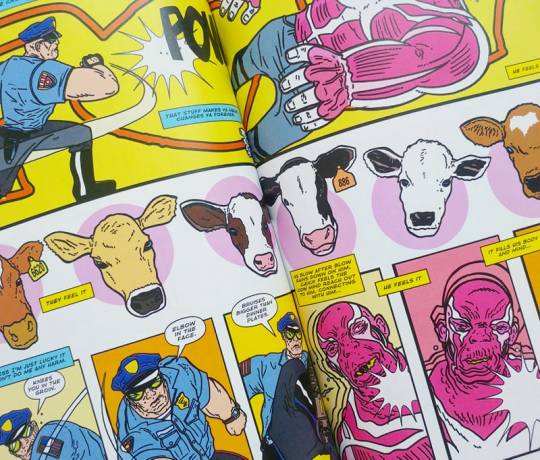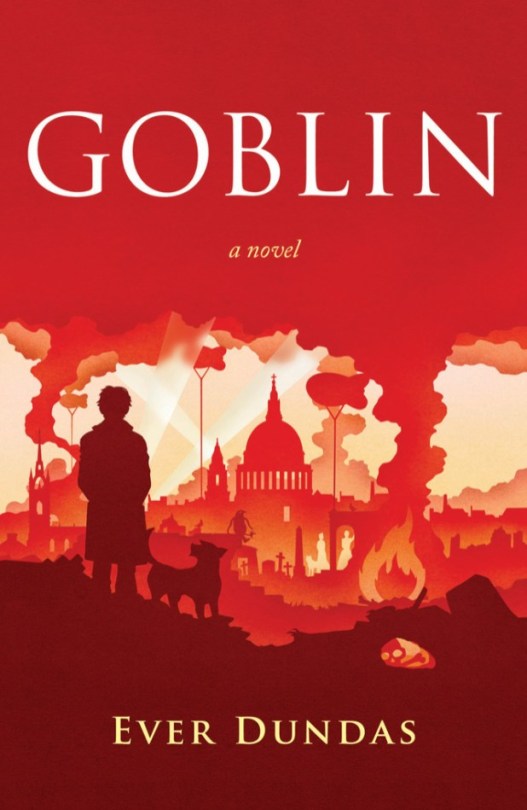The Beef.

A Frankensteinian superhero for the fast food era where no radioactive spiders or chemical plant explosions are required – just a steady, tasty diet of.. the beef.
“Chuck Carter is a good man. Chuck has shot penetrating bolts into the skulls of approximately 23,000 cows in his lifetime. This hasn’t affected him at all.”
The combination of Richard Starkings & Tyler Shainline’s bleakley satirical writing with Shaky Kane’s gloriously garish artwork creates the perfect marriage of love/hate Americanna – both indulging in and vilifying it’s reference points. It’s hard not to love the nostalgic crassness of the signposts of American culture and this story allows the reader to revel in it’s plasticy glory whilst also, not so much peaking below the surface as ripping the skin off and making you stare at the pulsing viscera underneath.
As fun and entertaining as it is horrifying and grim, it’s a rare (pun intended) comic book than can successfully take down consumption culture in all its forms (food, labour, sex) and include a two-page spread on the ugliness of the dairy industry with an unflinching focus on the most grooey home truths without veering into over-worthy browbeating. You’ll finish The Beef with a gnawing feeling in your stomach – it’s probably guilt, but it might be hunger.
AUTHOR: Richard Starkings / Tyler Shainline / Shaky Kane
TITLE: The Beef
Book Review: Goblin by Ever Dundas

Cover artwork by Cinnamon Curtis
An often dark novel with a non-linear timeline and an unreliable (and thoroughly bizarre) protagonist, this book could so easily have been a confusing, unreadable mess – but instead it is compelling, moving and strangely ‘real’. The portrayal of wartime London is evocative and raw and the author’s grasp on the mind of a young child remarkably authentic – a tough trick to pull off. Whilst it is far from being a piece of kitchen-sink realism it can be read in a more realist sense as an exercise in subterfuge, in shielding from the horror of reality through the escape into fantasy or as a literal ‘other’ world co-existing with our own, unseen. The story traverses a weird and wonderful collection of places, characters and themes including gender, sexuality, outsider status, the meaning of family and the treatment of animals. Indeed the book is teeming with fantastic beasties and creatures both recognisable and fantastical.
It is a vividly drawn, frequently sad and at times completely gut wrenching story of loss, abandonment and cruelty – but it is also strangely life affirming and I would hesitate to call it bleak despite so much of the subject matter being so. Goblin herself is a hugely entertaining character and there is a great deal of humour and ‘joie de vivre’ to be found amongst the rubble. The plot is engaging but really it is the characters who drive this novel and they will stay with you long after they have left the story themselves, or indeed after you close the book.
When you get to the end you will want to start all over again..
Review: The Cukoo’s Calling by Robert Galbraith (JK Rowling)
More consistent than The Casual Vacancy (although its highs were higher and lows lower) I found this to be an enjoyable, easy going whodunit that for the most part kept me engaged. Whilst the central characters felt quite cliched at the start they were fleshed out well throughout the story and by the end of the book were well poised for a sequel.
If I have any negative comments it’s that there is a strange combination of page-turner and long-windedness present in both this and The Casual Vacancy. Buried inside this book is a really gripping yarn half it’s length although unlike The Casual Vacancy it’s not as obvious to pinpoint where the extraneous information is. I never really felt bored while I was actually reading it, more that it just seemed to take far too long to get to the point. I’m a pretty gullible reader and never guess the endings to these things but in this case I did – I suspect mainly because I had so much prelude during which to wander through all the possibilities in my mind.
So to sum up..
A decent holiday read if not something that will blow your mind. Less divisive than The Casual Vacancy but ultimately less interesting too.
Hopefully there will be a slightly more brutally edited sequel to look forward to at some point soon.
Read it if you like: Colin Dexter, Jodi Picoult, Elizabeth George
7/10
Fanzine
`A loving look at this DIY strand of publishing, from its earliest incarnations up to modern day online`E-Zines’
This is the ultimate book on Fanzines an amateur magazine produced by fans, for fans of a certain subculture. This highly visual illustrated book is full of reproductions of the best fanzines ever created, from the superhero tributes of the 1950s and 60s, to punk fanzines such as Sniffin Glue, right up the contemporary e-zine scene. Arranged in six chronological chapters, each with a thorough introduction, Fanzines spans eight decades of counterculture and features many extremely rare publications. Written by a fanzine collector and expert author, Fanzines has cult appeal for anyone interested in graphic design, magazine publishing or underground culture.
I would love to get hold of a copy of this 🙂
